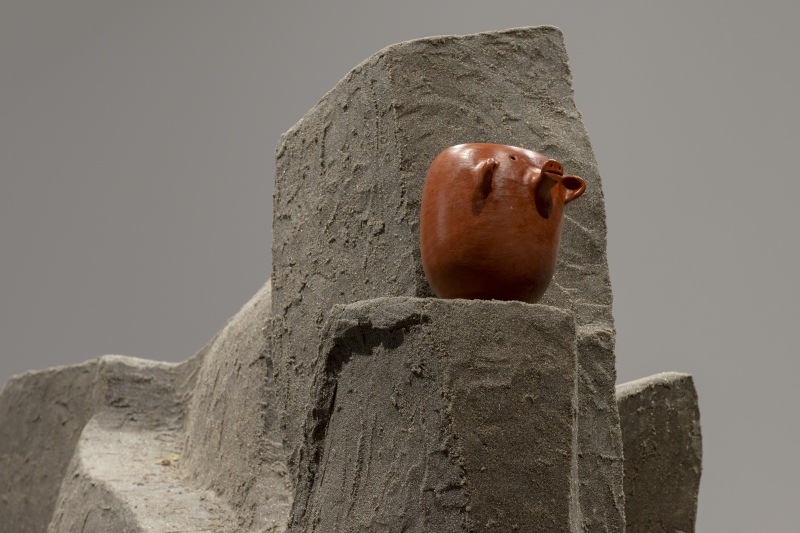Maria Loboda
Sitting Here Bored Like a Leopard
In her artistic statements, Maria Loboda uses a unique vocabulary that taps a wealth of cultural layers from antiquity to modernity and up to the very contemporary. Language and communication play an immensely important role in her work. Loboda’s art is like the writing and rewriting of extraordinary stories, which she manipulates, distorts, and renders dysfunctional. Sitting Here Bored Like a Leopard at the Ujazdowski Castle Centre for Contemporary Art is the artist’s first solo exhibition in Poland comprised almost exclusively of new works: sculptures, photographs, objects, and a stained-glass composition.
Considering the rather enigmatic and elusive nature of Loboda’s work, one can say that she analyzes communication systems, or venture to say that she simply likes to tell stories. Usually rather surprising ones, rooted in her personal fascinations , passions, or even obsessions, which, however, gain in her works a universal dimension.
“I always try to build the show around a small story – a haiku, as it were – so that all the works ‘belong to each other’ and interact.” As befits a fan of Alfred Hitchcock, Agata Christie, Raymond Chandler, or Edgar Allan Poe, Loboda skilfully draws attention away from the meanings and senses of her works and turns it instead towards the codes, metaphors, symbols, and puzzles they contain. It is the medium of the exhibition that determines the message. She always builds the show as a logical structure, but also seeks to distort the cohesiveness of the narrative.
For Loboda, art is a responsible and risky operation: the artist translates words, their referent concepts, reflections, or situations, into material things, objects, which usually adopt the quality of ready-mades. As a material, language sometimes reaches its limits and to tell the full story, the artist needs to use an object.
The titles of works and exhibitions are highly meaningful for Loboda; read through them and you will have found a helpful map to navigate you through those obscure, magical, and weird stories whose mood is reminiscent of the films of David Lynch: nothing is really what it seems here.
The show borrows its title from Sylvia Plath’s poem Leaving Early (1960), and the paraphrase of a fragment sitting here bored as a leopard was the point of departure in developing its concept. A bored, lazy predator is calm and deadly at the same time: a mortal danger is expressed here not through tension, but through tedium. A sensual image, a calm before the storm. A threatening boredom that can also be an existential boredom, a source of nihilism or anarchy.
A gate with three tall and graceful entrances reminiscent leads into the exhibition space as if into an Egyptian temple. This however is a dysfunctional temple, a site where a strange, invisible deity is worshipped; or perhaps it is the lobby of some indeterminate office, agency, corporation, power, and prestige? This is suggested by the shadow a venetian blind casts on the gate’s façade. A combination of the sacred and the profane, which is neither. The exhibition’s highlights include fair-sized sculptures, their aesthetic neutral and modern, which the museum guards on duty can relax in. This is a sly, subtly anarchist gesture towards artworks which are protected from the viewer’s touch.
Deeper into the show, we encounter references to the figure of the businessman, here extracted from Edgar Allan Poe’s scathing satire The Business Man, as well as motifs derived from film noir where the criminal is a metaphor of the “dark” and incomprehensible side of human nature. The refined colour palette of American Gigolo appears in a monumental stained-glass composition showing a scene from the movie. The motif of the blinds returns here, casting a shadow in the scene where Julian searches through his apartment in panic. Venetian blinds are inherent to noir-cinema style, but also to office aesthetics.
Jean-Luc Godard said that story should have a beginning, a middle, and an end, but not necessarily in that order. Maria Loboda’s art follows the logic of poetry – it forces and encourages you to interpret and to search for a key to the secret message.
Born in 1979, the artist has been based in Germany for over thirty years; she is a graduate of the Städelschule Frankfurt, an academy that offers its students a maximum of creative freedom, focusing on complete independence from all non-artistic constraints or goals. Maria Loboda has participated in dOCUMENTA (13) and the 2014 Taipei Biennale, exhibited at the Museo Reina Sofia in Madrid and the Palais de Tokyo in Paris, and this year has been invited for the main show at the Venice Biennale. In 2015 Loboda did a project for Kraków’s Bunkier Sztuki, she has also participated in the Tatra Conference (Kraków, Zakopane) and in The Mycological Theatre in Rabka, at Paulina Ołowska’s Kadenówka, but she hasn’t had an opportunity yet to present a larger body of work to the Polish public.






















